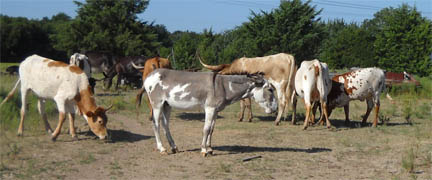Farm & Ranch
Why predators fear the long ears: Donkeys are proving their versatility as guard animals

By Martin Aldridge
“They keep them out of the pasture,” says Yvette Garza of Celina.
She’s talking about her three donkeys, and what they keep out of the pasture are the ever changing pack of dogs she fosters as founder of Lost Paws Rescue of Texas, a non-profit organization that rescues and adopts out all manner of canines and felines. New dogs, she says, learn quickly the pasture is off limits.
Garza describes her donkeys as “spoiled” and hasn’t really considered them as guarding anything, though she admits the chicken coop doesn’t attract much trouble, something she attributes to her long-eared friends. But even so, the behavior these donkeys display is one of the main reasons the use of guard donkeys is becoming increasingly popular.
“Donkeys aren’t guarding the cattle or sheep, per se,” says Leah Patton of the American Donkey & Mule Society, headquartered in Lewisville. “They are defending their family flock from predators.
“The donkey doesn’t care whether the herd baas or moos or grunts,” she says. “The donkey is concerned with the dog or coyote that is lurking. Whatever animal the donkey is bonded with, it will defend. Donkeys can do just fine with sheep, goats, cattle, llamas, horses, ponies – some people even say with chickens or other fowl.”
Patton should know – she has raised guard donkeys as well as used them with her cattle.
Yet despite the growing awareness of donkeys’ ability to guard livestock, the concept is a very old one.
“Shepherds have used donkeys to aid them in tending flocks for many centuries,” Patton says. “The donkey helped elevate the shepherd a little, extending his viewing area, allowed him to move a little faster, further and longer, and if need be, carry extra supplies. This practice has probably been going on as long as people have had donkeys as beasts of burden, and kept flocks of sheep.”
The current trend for using guard donkeys is indeed connected with a desire to protect sheep and goats. In the past, predators were largely controlled by using various poisons, but the passage of a federal ban against all toxicants in 1972 (since relaxed somewhat), as well as growing public disapproval against killing predators, left shepherds scrambling for alternatives.
Texas leads the nation not only in cattle, but in sheep and goats as well, so it’s no surprise some of the best information regarding the effectiveness of guard donkeys comes from the Texas Department of Agriculture (TDA). To read more pick up the April 2014 issue of North Texas Farm & Ranch.
Farm & Ranch
Managing Show Cattle Through The Winter

By Heather Welper
Husband and wife duo, Heather and Calvin Welper, are the Co-Owners and Operators or Two C Livestock, located in Valley View, Texas.
The pair’s operation has a show cattle focus where they raise and sell purebred heifers of all breeds and club calf Hereford steers.
When it comes to show cattle, the Welpers know a thing or two including how to prepare for the cold winter months and the Texas major show season run.
To read more, pick up a copy of the November edition of North Texas Farm & Ranch magazine, available digitally and in print. To subscribe by mail, call 940-872-5922.

Farm & Ranch
Double M Ranch & Rescue

By Hannah Claxton, Editor
As the sun rises each day, so do the dozens of mouths that Meghan McGovern is responsible for getting fed. Rather than the sounds of a rooster crowing, McGovern hears the bellows and bleats of a variety of exotic deer, the chortle of kangaroos, the grunts of water buffaloes, and the chirps of a lemur.
Nestled against the banks of the Red River, the Double M Ranch and Rescue, with its high game fences and deer sprinkling the landscape,s its in stark contrast to the surrounding ranches.
“Having deer is kind of like eating potato chips- you can never actually have just one,” said McGovern with a laugh.
McGovern has several herds to take care of- fallow deer, axis deer, water buffalo, goats, and bison. In smaller numbers, there’s also a few kangaroos, a lemur, a potbelly pig, a pair of zebras, a watusi, and a few horses.
To read more, pick up a copy of the November edition of North Texas Farm & Ranch magazine, available digitally and in print. To subscribe by mail, call 940-872-5922.

Farm & Ranch
Acorn Toxicity

By Barry Whitworth, DVM, MPH
With the prolonged drought, most pastures in Oklahoma end up in poor condition. With the lack of available forage, animals may go in search of alternative foods.
If oak trees are in the pastures, acorns may be a favorite meal for some livestock in the fall. This may result in oak poisoning.
Oak leaves, twigs, buds, and acorns may be toxic to some animals when consumed.
To read more, pick up a copy of the November edition of North Texas Farm & Ranch magazine, available digitally and in print. To subscribe by mail, call 940-872-5922.

-

 Country Lifestyles2 years ago
Country Lifestyles2 years agoScott & Stacey Schumacher: A Growth Mindset
-

 Country Lifestyles8 years ago
Country Lifestyles8 years agoStyle Your Profile – What your style cowboy hat says about you and new trends in 2017
-

 HOME8 years ago
HOME8 years agoGrazing North Texas – Wilman Lovegrass
-

 Outdoor10 years ago
Outdoor10 years agoButtercup or Primrose?
-

 Country Lifestyles5 years ago
Country Lifestyles5 years agoAmber Crawford, Breakaway Roper
-

 Equine1 year ago
Equine1 year agoThe Will to Win
-

 Country Lifestyles9 years ago
Country Lifestyles9 years agoJune 2016 Profile – The man behind the mic: Bob Tallman
-

 Country Lifestyles8 years ago
Country Lifestyles8 years agoDecember 2016 Profile, Rusty Riddle – The Riddle Way




